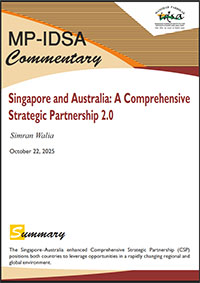Singapore and Australia: A Comprehensive Strategic Partnership 2.0
- October 22, 2025 |
- IDSA Comments


Australia and Singapore share a long-standing, multifaceted relationship built on strong economic, defence, strategic and people-to-people ties. Singapore’s Prime Minister Lawrence Wong visited Australia, Canberra, from 6 to 9 October 2025 and met Australian Prime Minister Anthony Albanese for the 10th Singapore–Australia Annual Leaders’ meeting.[1] His visit coincided with the marking of 60 years of bilateral diplomatic relations and was his first official visit to Australia since taking office in 2024. One of the main agendas of the meeting was updating their bilateral partnership for the next 10 years through an enhanced Comprehensive Strategic Partnership (CSP) 2.0.[2]
In 2015, Singapore and Australia launched the first CSP, which has yielded significant and tangible benefits for both countries.[3] The CSP is a framework established to deepen bilateral cooperation across various sectors, including defence, trade, education, science, innovation and people-to-people links. In the earlier CSP, key features included expanding cooperation in defence and security through joint exercises and training, trade and investment opportunities under frameworks like the Singapore–Australia Free Trade Agreement (SAFTA) signed in 2003 and expanding people-to-people ties.[4]
Building on the initial CSP inked in 2015, the updated partnership, CSP 2.0, includes 80 projects, 20 agreements and memorandums of understanding (MoUs), and 11 additional ‘conversations’ on climate change and supply-chain resilience. These discussions addressed several areas of bilateral cooperation, such as fostering regional and domestic peace and stability, strengthening economic ties, and the countries’ shift to net-zero emissions targets. Strengthening collaboration in defence, supply chain resilience, green and digital economies, food security, renewable energy, and innovation, as well as emerging fields like artificial intelligence (AI) and space, are all included in the CSP 2.0. According to PM Wong, CSP 2.0 would promote collaboration in cutting-edge fields like artificial intelligence and space, improve their green relationship, and increase economic connectivity and security cooperation between the two countries.[5]
The 2015 CSP was more about setting directions, while CSP 2.0 delves deeper into detailed MoUs, dialogues and initiatives to boost bilateral cooperation between the two nations. In 2015, there was less emphasis on ‘resilience’ in areas like supply chains and economic shocks compared to the updated CSP. The global disruptions caused by COVID-19 and other recent events have brought these issues to the forefront.
Singapore and Australia enjoy a strong and dynamic economic partnership, with bilateral trade reaching US$ 30.3 billion last year (January–December 2024).[6] This makes Australia one of Singapore’s leading trading partners. Singapore is also the sixth-largest foreign investor in Australia, with significant investments spread across key sectors of real estate, energy and infrastructure. The five biggest investors in Australia are the United States, Japan, France, Germany and Canada. Singapore and Australia also signed a landmark MoU on Economic Resilience, a first for both countries. This agreement underscores their deep strategic trust and joint commitment to strengthening economic resilience through cooperation in key areas such as cyber and digital technologies and supply-chain resilience.
CSP 2.0 emphasises the green economy agreement (GEA) signed in 2022, introducing new annexes on green shipping corridors and cross-border electricity trade. It also highlights emerging areas like AI, cybersecurity, and the digital economy. Furthermore, to strengthen people-to-people ties, the upgraded CSP aims to increase scholarships and educational exchanges, enhance student well-being, and promote cultural diplomacy and tourism. These initiatives reflect a shared commitment to tackling global challenges and harnessing opportunities for sustainable growth.
Boosting Defence Ties
One of the key highlights of the updated CSP 2.0 is the focus on bolstering defence cooperation. PM Wong announced that Singapore and Australia have agreed to strengthen their defence ties by allowing greater reciprocal access to each other’s naval and air bases and signed an MoU on Enhanced Defence Cooperation.[7] While both countries share a strong and enduring defence partnership, the agreement aims to enhance collaboration by providing more support and access to Singapore’s naval and air bases. Such an arrangement would also allow Australia to deploy more of its forces in the Indian Ocean Region and also facilitate Australian participation in security operations, joint exercises, and humanitarian assistance missions in Southeast Asia and the Indo-Pacific. Singapore views Australia as “a resident power in Asia”, whose ongoing presence helps maintain stability and security for all nations.[8]
PM Albanese said that better access to Singapore’s ports and air bases is essential for Australia to boost its presence in Southeast Asia. It is a natural next step in their long-standing defence partnership. Both countries have also agreed to strengthen cooperation in defence technology, logistics, and supply chains and increase professional exchanges between their militaries. Pertinently, since 2020, under the Australia–Singapore Military Training Initiative, up to 14,000 Singapore Armed Forces personnel can train in Queensland for up to 18 weeks annually over 25 years.[9]
Deepening defence cooperation between Singapore and Australia is a logical step amid growing uncertainty over the future direction of US foreign policy. While both nations have consistently supported a strong US security presence in Asia, the shifting landscape makes it increasingly important for them to strengthen bilateral ties and enhance regional security collaboration.
Australia is also eager to strengthen its trade and investment ties with Southeast Asian countries through initiatives like its Southeast Asia Economic Strategy for 2040 and an A$ 175 million contribution to Singapore’s Financing Asia Transition Partnership (FATP).[10] Southeast Asia Economic Strategy for 2040 outlines a long-term vision for enhanced economic ties, infrastructure development, and sustainable growth across the region. Additionally, FATP is a collaborative effort to mobilise investment in green and sustainable projects across Asia. This partnership highlights Australia’s strategic approach to supporting the region’s transition to a low-carbon economy while fostering stronger economic linkages. Moreover, both nations will collaborate on a new Third Country Training Programme to provide capacity-building support for Southeast Asian nations.
Australia, being a Quad member and Singapore, located at the crossroads of major maritime routes, share a common interest in the stability of the Indo-Pacific region. Both recognise the vitality of ASEAN centrality in the area. Therefore, their enhanced defence cooperation under the CSP 2.0 will serve as a crucial framework for deepening collaboration to tackle shared challenges such as geopolitical tensions, climate change and economic disruptions, and promote inclusive, sustainable growth across the Indo-Pacific.
It is fair to say that the priorities of both countries have gradually evolved in tandem with their political and economic development. One instance of this is their deepening commitment to the multilateral trading system and international rules and norms that underpin their shared prosperity. Singapore sees Australia as a vital strategic and economic partner in the Indo-Pacific, while the latter recognises Singapore’s importance as a financial and logistics hub in Southeast Asia.
In the current scenario, the global landscape has grown more complex, marked by supply chain disruptions, rising security challenges in the Indo-Pacific, climate change and technological competition. CSP 2.0, therefore, seeks to respond to these evolving issues and strengthen both nations’ capacity to address these challenges, uphold a rules-based international order, and help both countries to leverage opportunities, especially in a rapidly changing regional and global environment. As two highly globalised, open economies with deep strategic interests in a stable Indo-Pacific, Australia and Singapore are poised to serve as key anchors of regional cooperation.
Views expressed are of the author and do not necessarily reflect the views of the Manohar Parrikar IDSA or of the Government of India.
[1] “10th Singapore-Australia Annual Leaders’ Meeting”, Ministry of Foreign Affairs, Singapore, 8 October 2025.
[2] “Australia-Singapore Comprehensive Strategic Partnership (CSP) 2.0 2025-35”, Department of Foreign Affairs and Trade, Australian Government, 8 October 2025.
[3] Euan Graham, “The Lion and the Kangaroo: Australia’s Strategic Partnership with Singapore”, Lowy Institute, 12 May 2016.
[4] Ibid.
[5] Fabian Koh, “Singapore, Australia Upgrade Strategic Partnership to Boost Security, Economic Ties”, CNA, 8 October 2025.
[6] Ibid.
[7] “Australia and Singapore Enhance Defence Cooperation”, Australian Government, 8 October 2025.
[8] “Press Conference – Canberra”, Prime Minister of Australia, 8 October 2025.
[9] Tom Abke, “Singapore’s Military Training Efforts Produce a Jobs Windfall for Australia”, Indo-Pacific Defense Forum, 13 July 2020.
[10] Anjali Raguraman, “Singapore, Australia Upgrade Ties; Will Deepen Cooperation in Defence and Energy, Among Others”, The Straits Times, 8 October 2025.






